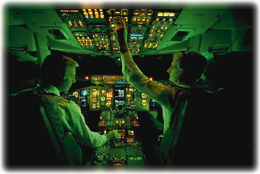Main Menu · Search · Current Issue · Contact · Archives · Centennial · Letters to the Editor · FAQs
![]()
Main Menu ·
Search · Current Issue · Contact · Archives · Centennial · Letters to the Editor · FAQs

| High School Physics: A Dead End? | Consuming Passions | |
| Cockpit Teamwork | Antimatter: Some Like It Cold | |
| E-mail and Web Information | ||
 Air safety increases with stable cockpit teams.T. TRACY/FPG INTERNATIONAL |
The culture of flying, even today, accords highest status to the great "stick-and-rudder" pilot, scion of the iconographic individual in goggles and white silk scarf. But despite the individualistic orientation of pilots, cockpit crews are teams, says J. Richard Hackman, Cahner-Rabb professor of social and organizational psychology, and the captain is the team leader. Few people in aviation would regard that as a controversial assertion, yet, if taken seriously, it suggests that the world of work for crews (and therefore us fellow travelers) is not as safe as it could be.
Research has demonstrated that in the great majority of crashes and lesser accidents, the aircraft is mechanically functional and crew members are well-trained and healthy. It's the team that goes on the fritz.
Hackman and colleagues gathered data from more than 300 crews at 10 airlines in the United States and abroad, and he has reported the work in a chapter in Cockpit Resource Management. Hackman found that when hiring pilots, most airlines pay little attention to assessing the ability of candidates to work in teams. Training of cockpit crews now does emphasize teamwork, but the schooling goes best if the pupils find the lessons agreeable and have the interpersonal skills to do well at them.
Even when members of a team--any team--have superb technical and interpersonal skills, they need practice together to perform well. A colleague of Hackman's has discovered that cockpit crews given fairly demanding simulated flight tests after flying together for several days made fewer errors, even when tired, than fresh crews just assembled. Other research has shown that the majority of the trouble crews get into comes on the first leg of the first day of their time together. Ideally, crews would remain intact for a long time. Typically, however, the lifespan of a crew is a mere one or two days. When highest performance counts and money is no object, some military organizations, such as the Strategic Air Command, do approach the ideal, using "hard crews" that stay together. "Everybody agrees that it would be better to have hard crews," says Hackman, yet airlines and pilot unions prefer the system the way it is.
Unions have negotiated contracts that give individual pilots more choice in choosing work schedules than would be possible under a system that fostered the integrity and stability of crews. Senior pilots have the most choice, and, says Hackman, "they would rather fly twice a month to Hawaii than twice a day to Dayton."
"Airlines consider each employee and piece of equipment as a single unit," says Hackman. "They switch pilots, flight attendants, and aircraft around from day to day, or even within a given day, and achieve real efficiencies in that way. A normal day's flying for a crew can involve two or even three changes of aircraft and as many different cabin crews. The composition of the cockpit crew itself may change. If, say, an airline considered pilots as groups of two or three, the loss in scheduling flexibility would cost millions of dollars."
~ Christopher Reed
Main Menu ·
Search · Current Issue · Contact · Archives · Centennial · Letters to the Editor · FAQs
![]()